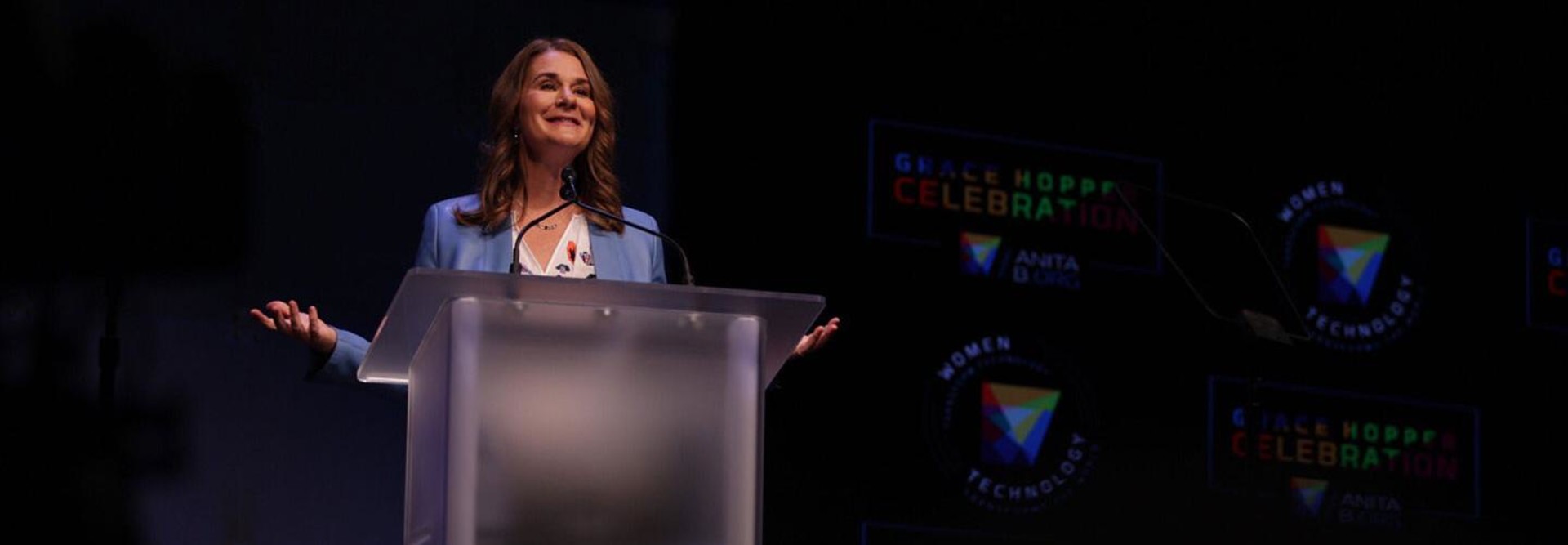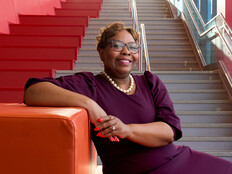Melinda Gates Pushes to Get More Women into Tech
Melinda Gates has a message for the tech world that it better get used to: The next Microsoft won’t be founded by someone like her husband.
Gates, co-chair of the Bill & Melinda Gates Foundation, noted during a keynote speech Wednesday at the 2017 Grace Hopper Celebration of Women in Computing in Orlando, Fla., that the technology industry has been called by some “a sea of white dudes.”
Gates then showed a slide with a grid filled with her husband’s face, eliciting laughter from the crowd of about 12,000, CNET reports, at what is billed as the world’s largest gathering of women technologists.
It’s time the world starts recognizing that the next @BillGates might not look anything like the last one. #GHC17 pic.twitter.com/kPqLuCijHo
— Melinda Gates (@melindagates) October 4, 2017
Speaking on the opening day of the conference, hosted by AnitaB.org, Gates had a pithy retort to the idea that tech is designed for one type of person.
“Well, it’s time the world starts recognizing that the next Bill Gates might not look anything like the last one,” she said, “and that not every great idea comes wrapped in a hoodie.
“Right now, there’s a girl in elementary school whose ideas will one day change the world,” Gates continued. “It’s time everyone starts seeing her that way.”
To get more women into tech, Gates proposed that the audience rethink the traditional approach of getting young girls involved in and interested in science, technology, engineering and math (STEM). Instead, she proposed four courses of action:
- Broaden educational opportunities in tech beyond the classroom
- Put more emphasis on how tech can solve real-world problems
- Bring computing to other academic disciplines
- Allow women to get into tech at different points in their careers
Changing the Culture of Tech
Gates noted that in 2015, women made up only a quarter of the entire tech workforce — and held just 15 percent of the technical roles. African-American women made up just 3 percent of the tech workforce and Hispanic women just 1 percent.
“News flash: there’s a bug in the system. And it’s happening at the worst possible time,” Gates said, noting that the economy is expected to add half a million computing jobs in the next decade and there aren’t nearly enough computer science graduates to fill them.
“Which is just one reason why it’s imperative we break down the barriers keeping women out of this industry,” she said. As technologies like artificial intelligence become more pervasive, the workforce creating them needs to change.
“Just think about AI. You often hear that the big challenge is teaching machines to think and behave more like humans. I can’t help but think we should be more specific,” she said. “We don’t want to teach computers racism or sexism, or selfishness or greed. We want to teach computers the very best of what humanity has to offer.”
For that to happen, Gates said, “we need the people building AI to represent not just one small slice of the human experience, but all genders, ethnicities and backgrounds.”
Gates said the world needs to stop warning girls that the computer science field is hard, full of “brogrammers,” and that girls just won’t fit in.
In a reference to a recent controversy at Google, Gates said, “No more memos arguing that so-called biological differences make her less likely to be a good programmer. No more standing by as her dreams bump up against biases and barriers.”
The girl who dreams of getting into tech, Gates said, “deserves the chance to rise as high as her talents will take her. She deserves to have her voice heard, her perspective valued and her great ideas funded. And the world deserves the chance to see what she can do.”
Steps to Increase the Number of Women in Tech
Not every girl is going to go through the STEM pipeline and take computer science classes in high school and college. Gates noted that Grace Hopper used to say that she hated the phrase “We’ve always done it that way.”
“I think that if we want to see a sea change — if we want a wave of women in tech — then we need to open the flood gates,” she said. Gates proposed new pathways to get more women into IT. “What if, instead of one pipeline, we created new pathways — lots of them,” Gates said. “Or, to put it in coding terms: why not stop trying to get girls to meet the necessary conditions for each predetermined if-then statement? And why not start writing a series of for-loops?”
Gates proposed four ideas for doing so:
-
“For girls growing up, let’s create plenty of pathways to explore tech — inside and outside the classroom,” she said. “Oakland high schools have a great model where they partner with companies. Students learn tech skills in class and build projects with a mentor from the community.”
-
For women in college, the focus should be on showing how tech is a tool for solving real-world issues. “That simple fact was a game-changer for a woman named Ellora Israni,” Gates said. “She took her first CS class to fill a requirement. But then she realized, as she puts it, that ‘computer science is as much about computers as chemistry is about beakers.’” Israni is currently attending Harvard Law School “because she wants to use her tech skills to help improve our justice system.”
-
For women already majoring in something besides CS, Gates said universities should “offer programs that combine computing with the rest of their coursework and lead to degrees in fields like bioinformatics.”
-
Higher education institutions should offer more paths for women who discover their passion for tech at different times and places, Gates said. “For community college students, let’s create bridge programs that lead to a bachelor’s degree in CS, like they have at UC Davis,” she said. “And for women who’ve already graduated, let’s design master’s programs to help them transition into computing, like they do at Northeastern University.”
Gates challenged the 12,000 conference attendees to commit to helping 10 women get into or stay in tech, potentially reaching 120,000, which she noted is “more than the total number of Americans earning degrees in computer and information sciences each year.”
“And think about the ripple effect,” she said. “Those 120,000 women will reach more women. So will the women they talk to. That’s when things really start getting good. That’s when we’ll look around and see an industry as diverse and dynamic as the country we live in. That’s when it’ll hit us that we’ve created a sea change.
“So let’s go make some waves. Let’s keep moving this industry forward,” Gates said. “For the better. For everyone. And for good.”









